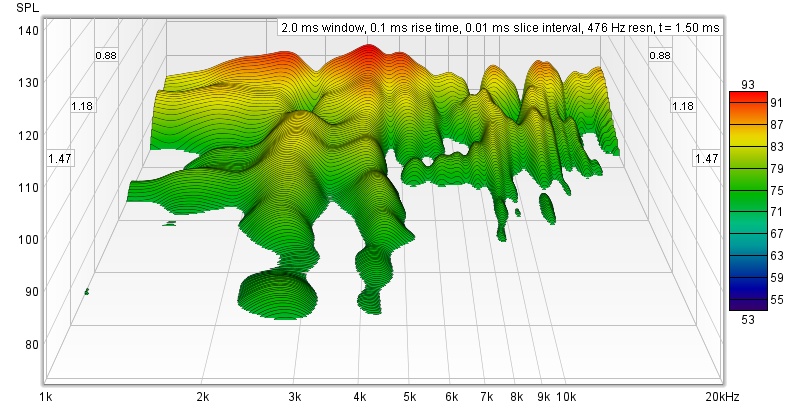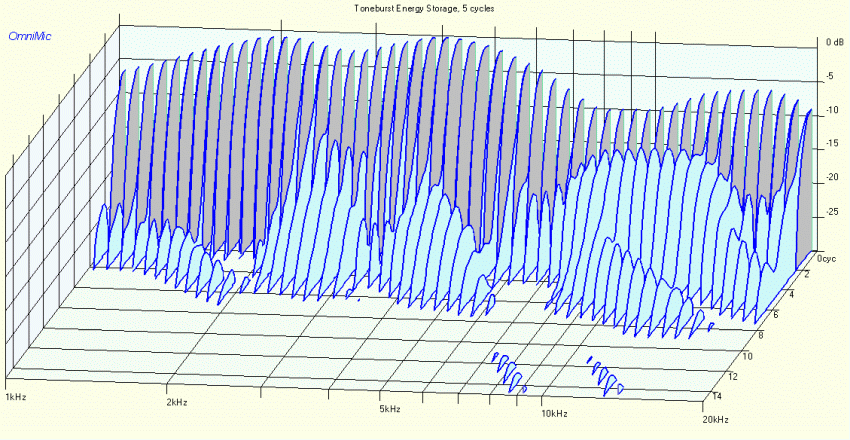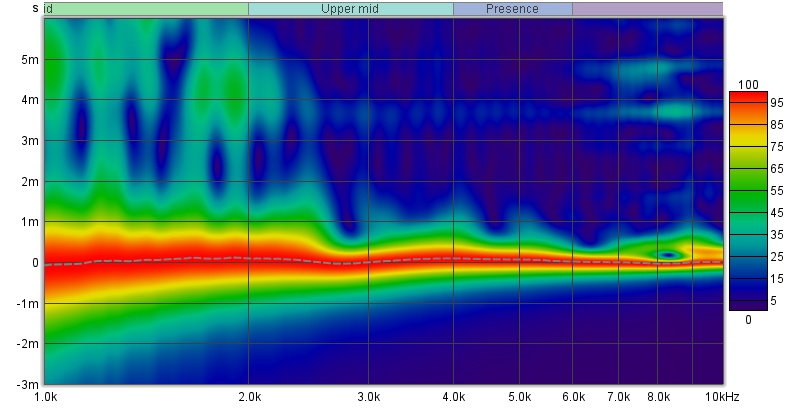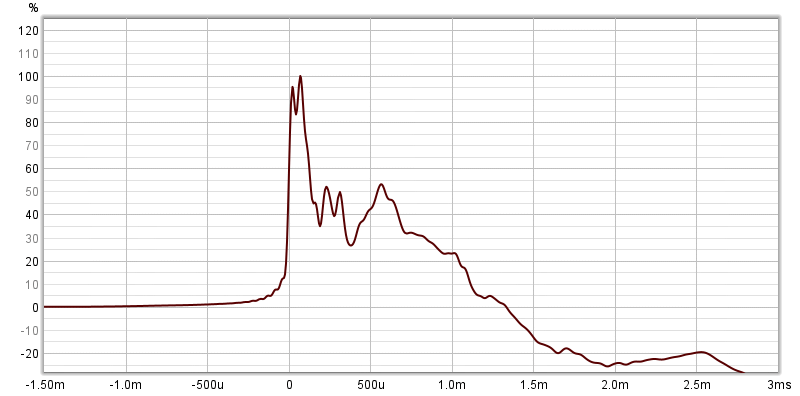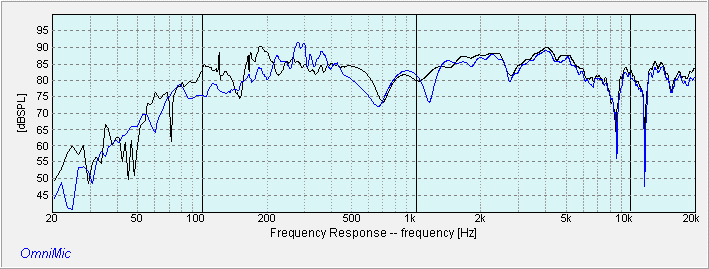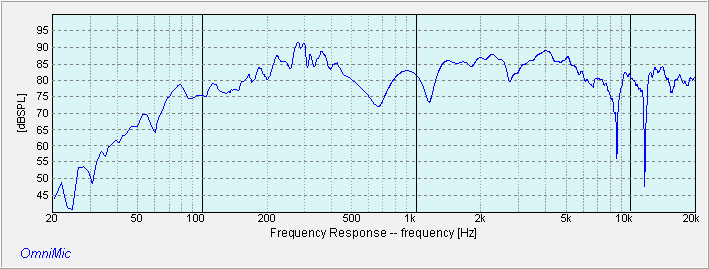|
Now that I have the T/S done, it’s time to examine this coax deeper. For a start, I disconnected the tweeter and measured the woofer itself.
Fig 1 is the RAW response of the Terminator 5 woofer in a 7 liters Sealed Box. Like the majority of car speakers, there’s no low pass filter. The woofer is used up to her limits. We can see she starts to roll off after 4kHz. Note the rather deep notch at 700Hz. My guess is it is something mechanical that results in the extended range.
Fig 2 is the response of the tweeter with a supplied 4uF high pass filter. The response is quite horrific. There’s a major notch at 7.5kHz and a deep one at 12kHz. The roll-off is about 4.5kHz. Normally I would not use such a tweeter but there’s nothing I can do about it because it’s part of this coaxial. Hopefully, once when she’s integrated with the woofer, these flaws will not be so apparent.
Fig 3 is the overlay of the woofer and the tweeter responses. I believe the tweeter sensitivity was deliberately made lower to avoid using resistors to attenuate it.
Fig 4 is the frequency response of a stock Terminator 5. There is some emphasis in the upper midrange at about 2kHz. Further up, there’s presence boost at 4kHz.
The Waterfall plot (Fig 5) shows the peaks at 2.5kHz and 4kHz. Beyond that, the treble artifacts are minor.
The light blue slices are the unwanted excess energy (Fig 6). The peaks at 2.5kHz and 4kHz are recorded as well as the artifacts in the treble. The ones of concern are those between 1kHz~2kHz.
The Spectrogram (Fig 7) shows the unwanted energy extending to 5msec from 1kHz~2kHz. During audition, I did not detect any smearing in the midrange because they are about 50dB below the fundamental.
The Step Response in Fig 8 recorded two peaks at the apex. The first one is the tweeter. This is followed closely by another peak which is the woofer. Note the extremely short time difference between the tweeter and the woofer. The tweeter is leading the woofer by a few microsec only. By all accounts, this Terminator 5 can be consider time-aligned.
The 2nd Harmonic is a low of 0.26% while the 3rd is at 0.296% (Fig 9). THD from 2nd~9th is 0.882%. This is slightly on the high side but again, it did not irritate my ears during auditioning. Auditioning the MTX Terminator 5 When I first heard the Terminator 5, it was unbearable. The music was “rough”. I thought to myself, is this what a cheap coax sounds like? However, I persevered. I ran the Terminator 5 for a few days hoping she’ll sound better. And true enough, the music is much more refined after that. With the Terminator 5 finally broken-in, I proceeded to do some serious listening. In this audition, I’m focusing on the midrange and treble. I want to determine whether the female vocals screech, how bad is the sibilance and finally the smoothness of the treble. As for the bass, I’m ignoring it because trying to get bass with a 5-1/4″ coax is futile. If I really want bass, I’ll have to resort to boosting it electronically or to use another woofer. It can be done but that’s later. Right now, let’s see how the midrange and treble perform. I played one of the most difficult albums I have of female vocals – Nana Mouskouri. Amazing Grace came out perfect. So did The Power of Love and many more. Up next is One Of These Nights (Eagles). No issues on the male voices. The vocal harmony can be clearly heard. There’s even good separation between the vocals and the band. MTX TERMINATOR 5 in Open Baffle One of the main issues with this Terminator 5 is the high Qts of 1.464. This results in a one note bass at about 125Hz. It’s audible and annoying. I suppose when in a car, it won’t sound so bad because of cabin gain. But in Full Space, something must be done to mitigate it. The obvious choice is to EQ the peak off. That will add another layer of electronics to the music. For purists, is there another solution?
Enter Open Baffle. The Black plot in Fig 10 is the RAW response of this MTX. The Blue plot is with the back panel removed. See how much of the response from 300Hz downwards is attentuated. This effectively killed off the 125Hz peak.
Fig 11 is the response of the MTX in Open Baffle. When listening to the OB MTX, you get that distinctive sound of the music being more “open” or “natural”. That’s due to the bass cancellation in OB. Because of that, the “boxiness” in the music is no longer there. However, OB is not perfect. Note the bump at 300Hz and second notch at about 1.2kHz. So effectively, I’m exchanging a peak at 125Hz caused by a woofer with high Qts with an emphasis at 300Hz and ringing farther up. And how does this MTX sound with Open Baffle? Well, like what is seen in the plot in Fig 11. Can I live with this? Not really. I’ve discarded this approach in favor of a Sealed Box. I’m crossing it at 300Hz (24dB/oct) to an 8″ woofer with an electronic crossover and the system sounds so much better than with an Open baffle. Summary This Terminator 5 is about half the cost of the Dayton CX120. The treble doesn’t measure as well as the CX120 but it’s hardly noticeable on playback. To make it into a full range speaker, support it with the 8″ Thruster. Something to think about for a future project. One final note. This Terminator 5 is not for playing loud. Great for background music while you’re on your PC. Unless otherwise stated, all measurements were made in Full Space (4 pi) with the mic at 36 ins, tweeter axis. Impulse Window=5ms. No smoothing applied. |

August 8, 2023Drivers Evaluation, HIFI DRIVERS


 Fig 3 – MTX Terminator 5 Woofer and Tweeter Response
Fig 3 – MTX Terminator 5 Woofer and Tweeter Response
